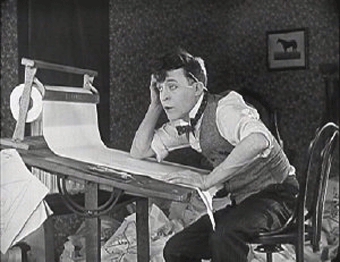
In his 2002 novel, The Book of Ilusions, Paul Auster invented his own silent movie comedian, a once celebrated figure forgotten by all but a few archival specialists. Hector Mann had disappeared in mysterious circumstances in 1929 and over the years his star had faded to obscurity. Then, in the early 1980s, canisters of his lost films began turning up in archives around the world.
It's hard not to think of Mann when confronted by the real-life story of Charley Bowers, a silent movie comedian/cartoonist who made his last proper film in 1930 and essentially disappeared too, although his vanishing act wasn't total or mysterious. He just went to live in New Jersey where he drew cartoons for the local paper until his death in 1946. But if it wasn't for a chance find of French copies of some of his films in the 1970s he would still be entirely unknown.
Although his screen persona was reminiscent of Buster Keaton, Bowers was only an average performer. What makes his films interesting today are their stop-motion flights of fancy. He's closer in temperament to someone like Georges Melies than to any of his contemporary comedians. His strange imagination was so pronounced that even Andre Breton, the principal founder of Surrealism, championed his first sound film It's A Bird (1930). In it, a comical, metal-eating bird consumes some car parts before laying an egg which proceeds to hatch a small, dark object that transforms into a full-sized car before our eyes. It's a little marvel of technical skill and private imagination following its own oddball reveries.
And then there's this madness. One of his twelve silent films, There It Is is a bizarre tale in which a house is terrorised by a little bald man called the Fuzz-Faced Phantom and a Scotland Yard detective is sent to investigate along with his assistant, an animated insect. If that sounds weird it's nothing to the actual film. It may not be very funny but that hardly matters when the actions of the Fuzz-Faced Phantom amount to nothing less than an attack on rationality itself, an exercise in epic randomness that has the illogic of a nightmare.
But my favourite Bowers moment happens near the end of probably his most successful film, Now You Tell One from 1926. In it, members of a Liars Club are competing to see who can tell the tallest tale. This section has some nice moments, especially the forty-seven elephants streaming into Capitol Hill, but then Charley tells them about a potion he's invented that allows him to graft anything onto anything else. Setting out to sell this potion he arrives at a farm overrun by mice where he grafts a much-needed cat from a plant. The result is a protoplasmic effusion of cats growing from this plant like balloons, bodies forming in seconds. It's a surrealistic image worthy of Rene Magritte or Max Ernst.
It's been said by some reviewers that Bowers' work flopped because it was just too far ahead of its time. America in the 30s, especially, was a bad time and place to be a farsighted filmmaker. Bowers chose to leave the business, and I don't know that I blame him.
ReplyDeleteThat could well be the case, pwlsax, although it could also be that despite his undoubted technical imagination Bowers' screen persona just wasn't that engaging. All the great silent movie comedians refined their personas through trial and error until they found the right one. (Chaplin, Lloyd, etc). Bowers persona seemed a mix of Harry Langdon and Buster Keaton without the pathos of the former or the deadpan charisma of the latter.
ReplyDeleteIt's an awesome paragraph for all the internet visitors; they will get advantage from it I am sure.
ReplyDeleteVisit my page exercises to increase vertical leap
electronic cigarettes reviews, ecig, e cig, ecigs, electronic cigarette starter kit, e cigarette
ReplyDelete